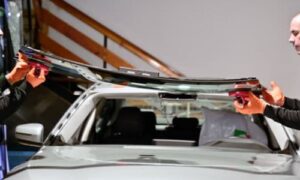When you drive, the tire rotates quickly; it will vibrate if they are not balanced. If it’s at the front, you’ll hear it loud and clearly and feel it in the steering wheel. Additionally, the vibration will harm components like your steering gearbox and wheel bearings. Even bolts like your lug nuts may go loose due to vibration. Your wheel might fall off after that because if it wobbles, the strain could cause the wheel studs to snap off (even if the lug nuts are not off, just loose).
Wheel Alignment: What Is It?
Your wheels and tires are roughly symmetrical, but not quite. Additionally, little objects like your valve stem have an insignificant weight that may become problematic when the wheel rotates rapidly. A wheel or tire is thus placed on a balancing machine, which turns it and locates any areas where counterweights are needed to balance the tire. You can see these little weights on the edge of your rim (on the inside if it’s an alloy wheel or the outside if it’s steel).
When a car’s wheels are correctly aligned, all its wheels are positioned as they should be. These settings often need to be adjusted over time as an automobile is used to maintain them correctly aligned. The proper wheel alignment considerably influences the dynamics of a moving car. Technically, alignment ensures that the Caster, Camber, and Toe geometric angles in a tire are correct. If you are unsure of these angles, don’t worry; you must get your tires aligned regularly. To learn how often this should be done, continue reading.
When should the alignment of the wheels be checked?
A curb struck your car or, heaven forbid, another vehicle, and now your tires are wearing unevenly or abnormally.
You have handling problems, such as the car tugging to the left or right and the steering not responding quickly after a turn. Check the wheel alignment at that service shop after replacing your steering and suspension parts. A wheel alignment is advised in any scenarios above or after driving for 50,000 kilometers.
What if you don’t care?
Due to the abnormal wear brought on by the incorrect wheel alignment, you will need a new set of tires relatively soon. The trip may not be as relaxing as your automobile salesperson promised. A correctly aligned wheel will provide proper tire wear, increasing the contact area between the tires and the road and boosting fuel efficiency. Due to the instability and potential risks that improper alignment may bring, you endanger yourself and your fellow passengers.
How much time does it take to get the wheels aligned?
Most front and rear wheel alignments may be completed between 30 and 60 minutes. Even though you may hear technical terms like castor, camber, and toe at the repair shop, wheel alignment is a relatively simple procedure. Your vehicle will be driven onto a platform that enables the wheels to spin while a computer analyzes the rotation and alignment of each wheel. Electronic specifications for the year, make, and model of your automobile will be examined. Each suitable wheel will be adjusted if these specifications are amiss so that they line up correctly. Your car will most likely be tested before and after the adjustment.
How can the equilibrium be regained?
A wheel balancing device that can detect weight differences of as low as 1/4 ounce (or 7 grams) around the wheel is used to assess the wheel’s balance. Others may ask why to care about such a tiny mass on a wheel that weighs several kilograms. Because of the speed at which that little amount of weight is rotating the axle—hundreds of times per minute—vibrations are being produced. And the wobbling increases when you multiply by four wheels.
Experts at service centers adhere to the following standardized procedures:
- Wheel and tire removal
- mounting every wheel on a cutting-edge balancing device
- Making ensuring that the weight of each wheel and tire is appropriately distributed around the axle by spinning each one
- Finding any imbalance, both static and dynamic (i.e., wheels checked, both at rest and in motion)
- adding a lead weight to the tire’s opposing side to account for weight variations
- replacing the wheels and tires
- Tire weight in zinc
- tire mass
Why Rotate Your Tires?
Be careful, boys. Tire rotation does not necessarily mean mounting your automobile and rotating your tires. Turning the front and rear tires is a technique used to balance wear. Due to the weight differences between the front and back axles, the load on the wheels is unequal by design. Tire rotation may be advised every 8,000 kilometers, depending on the vehicle’s characteristics. The sort of drive train, such as the rear wheel, front wheel, or four wheels, governs a basic tire switching or rotation rule.
Bottom line:
Suppose you’ve paid money to avoid using the dreaded public transportation and get where you’re going comfortably and securely. In that case, you should take care of these problems immediately to prevent more harm.



